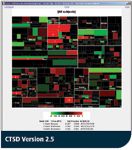eShowcase: CTSD Version 2.5
CTSD Version 2.5 provides improved data visualization and enhanced user interface
CTSD Version 2.5 provides improved data visualization and enhanced user interface
Phase Forward (Waltham, MA) has released Version 2.5 of its Clinical Trials Signal Detection (CTSD) system. CTSD detects, evaluates, and tracks potential safety signals, which allows biopharmaceutical companies to analyze and classify potential safety signals, develop a product safety profile, and make more informed decisions earlier in the drug development process.

CTSD 2.5 adds an enhanced user interface that features summary displays, data visualization tools, and access to trial data without programming. The user interface's interactive displays facilitate safety review workflow by including patient level drill downs, Lab Trend graphs, an Exposure Summary graph, and Kaplan-Meier plots. It also offers Hy's Law alerts and a full set of Standardized MedDRA Queries (SMQs).
The product is integrated with Phase Forward's Web Submission Data Manager (WebSDM) platform and offers CDISC support.
Phase Forward, (781) 890-7878, www.phaseforward.com

Improving Relationships and Diversifying the Site Selection Process
April 17th 2025In this episode of the Applied Clinical Trials Podcast, Liz Beatty, co-founder and chief strategy officer, Inato, discusses a number of topics around site engagement including community-based sites, the role of technology in improving site/sponsor relationships, how increased operational costs are impacting the industry, and more.
Behind the Buzz: Why Clinical Research Leaders Flock to SCOPE Summit
February 7th 2025In this episode, we meet with Micah Lieberman, Executive Conference Director for SCOPE Summit (Summit for Clinical Ops Executives) at Cambridge Innovation Institute. We will dive deep into the critical role of collaboration within the clinical research ecosystem. How do we bring together diverse stakeholders—sponsors, CROs, clinical trial tech innovators, suppliers, patients, sites, advocacy organizations, investors, and non-profits—to share best practices in trial design, program planning, innovation, and clinical operations? We’ll explore why it’s vital for thought leaders to step beyond their own organizations and learn from others, exchanging ideas that drive advancements in clinical research. Additionally, we’ll discuss the pivotal role of scientific conferences like SCOPE Summit in fostering these essential connections and collaborations, helping shape the future of clinical trials. Join us as we uncover how collective wisdom and cross-industry partnerships are transforming the landscape of clinical research.